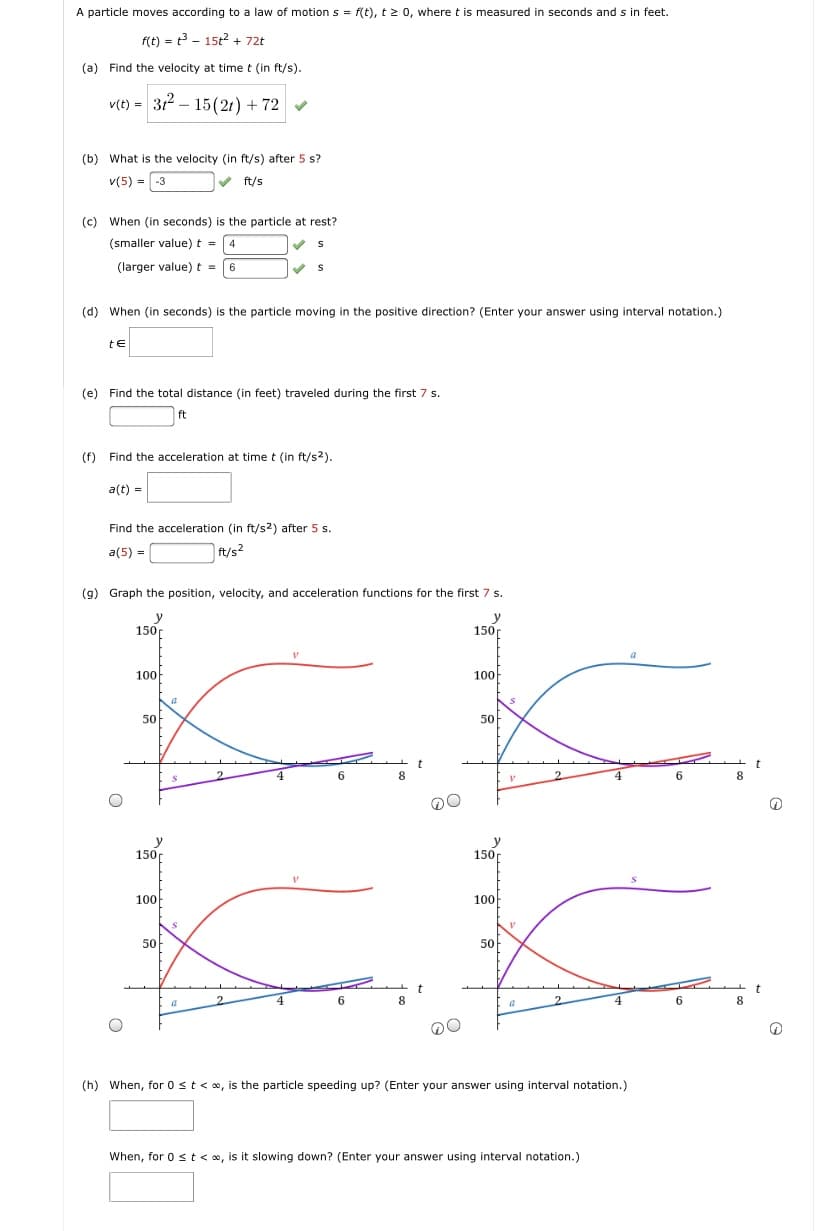A particle moves according to a law of motion s = f(t), t z 0, where t is measured in seconds and s in feet. f(t) = t - 15t + 72t (a) Find the velocity at time t (in ft/s). v(t) = 32 – 15(21) + 72 v (b) What is the velocity (in ft/s) after 5 s? v(5) = -3 ft/s (c) When (in seconds) is the particle at rest? (smaller value) t = 4 (larger value) t = 6 (d) When (in seconds) is the particle moving in the positive direction? (Enter your answer using interval notation.) te
A particle moves according to a law of motion s = f(t), t z 0, where t is measured in seconds and s in feet. f(t) = t - 15t + 72t (a) Find the velocity at time t (in ft/s). v(t) = 32 – 15(21) + 72 v (b) What is the velocity (in ft/s) after 5 s? v(5) = -3 ft/s (c) When (in seconds) is the particle at rest? (smaller value) t = 4 (larger value) t = 6 (d) When (in seconds) is the particle moving in the positive direction? (Enter your answer using interval notation.) te
Chapter3: Polynomial Functions
Section3.5: Mathematical Modeling And Variation
Problem 7ECP: The kinetic energy E of an object varies jointly with the object’s mass m and the square of the...
Related questions
Question

Transcribed Image Text:A particle moves according to a law of motion s = f(t), t2 0, where t is measured in seconds and s in feet.
f(t) = t3 - 15t2 + 72t
(a) Find the velocity at time t (in ft/s).
32 – 15(21) + 72
v(t) = v
(b) What is the velocity (in ft/s) after 5 s?
v(5) = -3
v ft/s
(c) When (in seconds) is the particle at rest?
(smaller value) t =4
(larger value) t =
6.
(d) When (in seconds) is the particle moving in the positive direction? (Enter your answer using interval notation.)
te
(e) Find the total distance (in feet) traveled during the first 7 s.
ft
(f) Find the acceleration at time t (in ft/s2).
a(t) =
Find the acceleration (in ft/s2) after 5 s.
a(5) =
ft/s2
(g) Graph the position, velocity, and acceleration functions for the first 7 s.
y
150r
y
150r
100
100
50
50
2.
6
8
4
6
8
150f
150r
100-
100아
50아
50
a
2.
6
8
2.
6
8
(h) When, for 0 st< o, is the particle speeding up? (Enter your answer using interval notation.)
When, for 0 st<o, is it slowing down? (Enter your answer using interval notation.)
Expert Solution
This question has been solved!
Explore an expertly crafted, step-by-step solution for a thorough understanding of key concepts.
Step by step
Solved in 2 steps with 2 images

Recommended textbooks for you


Algebra & Trigonometry with Analytic Geometry
Algebra
ISBN:
9781133382119
Author:
Swokowski
Publisher:
Cengage

Trigonometry (MindTap Course List)
Trigonometry
ISBN:
9781337278461
Author:
Ron Larson
Publisher:
Cengage Learning


Algebra & Trigonometry with Analytic Geometry
Algebra
ISBN:
9781133382119
Author:
Swokowski
Publisher:
Cengage

Trigonometry (MindTap Course List)
Trigonometry
ISBN:
9781337278461
Author:
Ron Larson
Publisher:
Cengage Learning

College Algebra (MindTap Course List)
Algebra
ISBN:
9781305652231
Author:
R. David Gustafson, Jeff Hughes
Publisher:
Cengage Learning